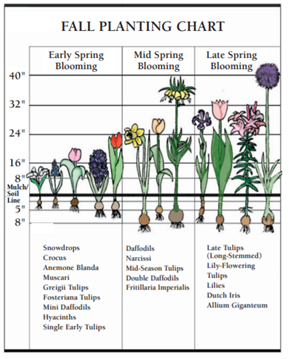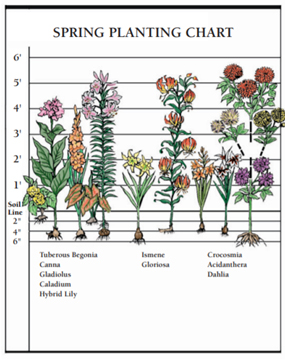-
Spring Planting
Order now for best selections.
-
Fall Planting
Available for preorder for fall 2025 delivery.
-
Bulk Flower Bulbs
Big savings on bulk orders!
- New
-
Gardening Resources
Flower Bulbs & Perennials at Wholesale Prices
How to Grow Flower Bulbs
Your flower bulbs have arrived from K. van Bourgondien, and it's time for them to be planted in your home garden or landscaped area. What do you need to know to give your bulbs their best chance of growing into strong, healthy plants that produce lots of beautiful blooms? How do you choose the right location for planting? What should be done to prepare the soil? How deep and far apart should bulbs be buried? With these tips for planting bulbs, we'll explain all that and more. You'll learn when to plant flower bulbs, the direction in which they should be planted (including how to figure out which end of a bulb is up), how often flower bulbs should be watered after planting and how long it takes bulbs to grow. We know this sounds like a lot to take in, but when you use this guide, we'll be with you every step of the way. Before you know it, understanding how to best grow flower bulbs will become second nature to you!
Tips for Planting Bulbs: A Complete Guide on Flowering Bulbs
Preparing the Soil
Fall is the prime time for planting hardy spring-flowering bulbs, and preparing soil is one of the most important parts of planting.
Bulbs and perennials need plenty of water and good drainage. If water has a tendency to stand in the planting area, you'll want to break up hard sub-soil and put in a layer of drainage material such as coarse gravel, broken stone or sifted cinders below your surface soil.
Summer-blooming bulbs are not fussy about soil, provided it is not too heavy and sticky. If soil is heavy, loosen it with lots of humus, sand, gypsum, etc. If very light, add moisture holders—humus, peat mold, etc.—to get the perfect soil heaviness. If you have a soil with a high clay content, it can be improved by adding compost, peat moss or some other source of organic material. The organic material should be worked into at least the top twelve inches of soil, up to the top 18 inches.
Fertilization
You know from science class that plants produce their own food—but it's still a good idea to mix in bulb food with your bulbs at planting. Do not apply fresh or half-rotted manure directly on bulbs and perennials. As soon as the shoots break through the ground in the spring, repeat the fertilizer application. When working with spring flowering bulbs, wait until after the plants have started flowering to add fertilizer; fertilizing the bulbs too early can cause bulb rot and shorten the plants' life. Summer and fall flowering bulbs should be fertilized monthly, starting at the time of shoot emergence, until the plants reach full flower.
Choosing a Location When Planting Bulbs
Before selecting the location to plant bulbs in the landscape, consider the light requirements of the plant. Does the plant require full sunshine, partial shade or full shade? Since early spring bulbs bloom before most trees shrubs leaf out, they can successfully be planted under trees and shrubs. Many summer blooming bulbs require full sun or partial shade. Spring bulbs planted on a south slope will bloom earlier than the same bulbs planted on a north slope. Spring Bulbs planted on a hillside will bloom earlier than bulbs planted in a valley. Cold air is heavier than warm air and behaves like water. It flows down the slope, settling in the low areas.
How Deep Should I Plant Bulbs?
Generally, you should plant spring bulbs two to three times as deep as the bulbs is tall. This means most large bulbs like tulips will be planted about 6 inches deep while smaller bulbs like muscari will be planted 3-4 inches deep. The depth of planting should be measured from the surface level of the soil to the shoulder of the bulb and the eyes or crowns of the perennials. Distance between plants is measured from the center of one plant to the center of the next.


How Far Apart Should I Plant Bulbs?
Plant enough bulbs for a showy display. For best appearance, plant bulbs in masses. Space bulbs in bed according to the size of the bulb. As a general rule, large bulbs, such as daffodils should be spaced 3 to 6 inches apart. Tubers such as dahlias should be planted at least 1 foot apart depending on the variety. Small bulbs, like anemones and snowdrops should be spaced 1 to 2 inches apart.
What Direction to Plant Bulbs

One of the most frequently asked questions about planting bulbs is, "Which end goes up?" It's important to know what direction to plant bulbs. Most true bulbs, such as tulips and daffodils, have pointed tips which should point upward. Corms, tubers and rhizomes usually show sprouts on their upper sides, and these should be on top when planted. Some of the smaller bulbs, like anemones, look like small dried peas or small stones and can be planted in any direction - their shoots will find their way toward the sun.
Tips to Keep in Mind When Planting Bulbs
You may wish to dig an individual hole for each bulb, tuber or corm. This can be done with a garden trowel or one of the special hole-cutting tools called bulb augers. Dig the hole several inches deeper than the recommended planting depth and fill to base level with a mixture of loose soil and fertilizer. Then place your bulb in the hole and cover it with loose soil. Using your fingers, gently push the soil into position around the bulb so there will be no air pockets where water can collect.
If you are planting an entire bulb bed, you can spade the whole bed area and then dig out the top 6-8" of soil. Place your bulbs atop the remaining loosened soil. After you have set them in place, you may want to add a bit of plant fertilizer, such as our Van Bourgondien 100% Natural Bulb Food. Then, cover the bulbs with the removed soil and water thoroughly.
These tips for planting bulbs are only guidelines—remember to check (and follow) the specific instructions packaged with your bulbs.
Do You Water Bulbs After Planting?
Yes, after planting, water the flower bulbs. This will help settle the soil in the planting bed plus provide needed moisture for the bulbs to start rooting. Fall planted bulbs must root before cold weather. Avoid over-watering at planting time since this can result in bulb rot.
If you're wondering how often to water bulbs after planting—average spring conditions should provide enough moisture for your bulbs. However, if the weather is unusually hot and dry, a weekly deep soaking will produce larger, longer-lasting blooms. For both spring and summer bulbs, start watering when the flower buds first appear on the plant if the soil is dry. Remember that the bulbs may have been planted 6 to 8 inches deep and the water needs to soak to that depth. Through the bud, bloom and early foliage stage, add about one inch of water per week if this amount has not been supplied from rainfall. Water with a soaker hose to keep water off the bloom. Bulbs like muscari, or the shallow planted bulbs, will rot quickly if over-watered in the heat of summer.
To learn more about planting spring and fall bulbs, check out our blog post on How to Plant Bulbs.
| Shop All Flower Bulbs |
| See More Tips |
Have another question? Return to the Customer Service Help page or send an e-mail directly to Customer Service
Copyright © 2025 Gardens Alive!, Inc. d/b/a Dutchbulbs.com. All Rights Reserved. Dutchbulbs.com trademarks are registered trademarks of Gardens Alive!, Inc.
This site is protected by reCAPTCHA and Google Privacy Policy and Terms apply.
This site is protected by reCAPTCHA and Google Privacy Policy and Terms apply.

Item added to cart





